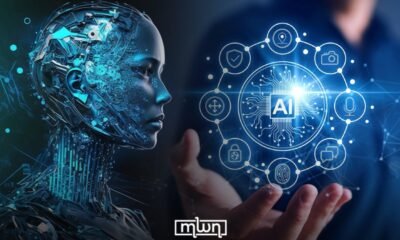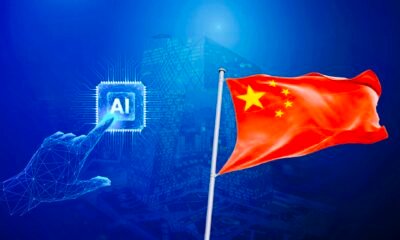Tools & Platforms
Amazon’s AWS has joined the AI agent craze. Now the real work of showing Fortune 500 companies how to actually use them begins

Amazon Web Services joined the agentic AI frenzy in a big way this week, revealing at a New York City event Wednesday a host of services and tools dubbed Agentcore that let technologists build and deploy so-called AI agents capable of automating internal tasks while potentially overhauling the way consumers interact with online businesses too.
These agents, to many in the tech industry, are the next evolution in our new AI-powered future, where artificial intelligence not only acts as an assistant, but can autonomously complete complex multi-step actions with just some human intervention in sensitive sectors like healthcare, and no human intervention in lower-risk areas.
But at least in the short term, the real battle between AWS and agentic AI competitors may depend less on technology differentiation, and more on who employs the most quality talent to help guide large corporations on where to even begin with AI agents.
Businesses “are frustrated because they want someone to tell them what to do and how to do it,” Dave Nicholson, chief technology advisor at The Futurum Group, told Fortune. “There isn’t enough [talent] to go around. Humans are the bottleneck.”
Nicholson added that AWS and other cloud and large tech companies will need to heavily lean on partner companies to assist with customer education and implementation too.
The business case for agents was pushed into the forefront last year by Salesforce, with the announcement of a new division it calls Agentforce. Google, OpenAI and other cloud and technology players have since rushed to announce AI agent tools and services geared toward corporations. On Thursday, a day after AWS’s showed off its agent tools, OpenAI announced a new, general purpose agent for users of its ChatGPT product.
Fear of missing out
With just about every CEO these days under pressure to craft an AI strategy, the incoming AI agents may be poised to capitalize on the situation.
“This is the highest level of ‘fear of missing out’ ever among behemoths in the IT industry right now,” Nicholson said. “These are existential decisions being made at Microsoft, Google, and Amazon.”
In an interview with Fortune after his keynote presentation announcing a new in-house collection of agent-building services dubbed AgentCore as well as a marketplace for agents, AWS VP of agentic AI, Swami Sivasubramanian said that Fortune 500 execs whose companies don’t start experimenting with the technology risk missing out on a transformational moment as pivotal as the creation of the internet.
“Agents are fundamentally going to change how we work and how we live,” Sivasubramanian said when asked how execs at Fortune 500 companies can be sure that their investments in building or deploying AI agents isn’t supplanted by a new shiny technology of the moment next year. The executive provided an example of how AI technologies will make it feasible for an agent to, for example, not only plan an itinerary for a trip, but do all of the bookings too.
“You can give it a high level objective, like, ‘Hey, create me a 10 day itinerary in December to visit Australia,’” he said. “It actually understands the objective. Breaks it down into…I need a flight, I need activities to go see in these cities, and then, based on my preferences, it creates a customized itinerary, and actually also secures reservations by calling APIs.”
That’s the type of personal, tangible, example that gives this AWS executive and other proponents of AI agents, the belief that many customer experiences can be overhauled, or created from scratch, with this technology — in ways that might even be hard to envision now.
Agentic rolemodels needed
Slick as some of these scenarios may sound however, the reality is that there are currently few examples of corporations using agents at massive scale. The green field of opportunity is sure to be attractive for some, but it’s also a big challenge for the companies selling agentic products and tools since there are not many real-world examples to guide or inspire.
Amazon Web Services’ market leadership in cloud computing should serve as some advantage, providing a large existing customer base to sell to. And because those companies’ operations are already dependent on AWS, they have more patience for any bumps Amazon experiences as it refines its AI agent business.
“They’re more likely to get two or three strikes,” Nicholson said of AWS and its AI agent rollout.
But it’s an open question whether AWS’ initial focus on heavily marketing its new agentic tools to software developers versus the executives with the purse strings will prove problematic.
“They have disjointed messaging,” Mark Beccue, an analyst at the research firm Omdia, told TechTarget. “When talking about agents, you must have the complete story.”
AWS’ Sivasubramanian said that most C-suite customers that he meets with naturally look inward to how their own organization runs when considering where and how to deploy AI agents first to help automate, or reduce the time to complete, boring, repetitive tasks.
This, of course, raises the question of when and how AI agents will disrupt or displace jobs and in which areas. Amazon CEO Andy Jassy recently weighed in on the overall AI boom in an employee memo, saying that while these technologies will both eliminate current roles while creating new ones, “we expect that this will reduce our total corporate workforce [over the next few years] as we get efficiency gains from using AI extensively across the company.” On Thursday, a day after AWS’ agent-focused summit, the company carried out layoffs of at least hundreds of employees.
A day earlier, Sivasubramanian, perhaps not surprisingly, struck an optimistic tone when discussing a new world full of AI agents that now Amazon — and many rivals — are rushing to bring to fruition.
“Yes, in the short term, if you look at [past] transformations, there were actually changes on the specific job categories [in which people worked], “but then we as humans have really adapted to these changes and then started working on different things. You don’t find people who are doing Y2K engineering anymore.”
Tools & Platforms
Your browser is not supported
azcentral.com wants to ensure the best experience for all of our readers, so we built our site to take advantage of the latest technology, making it faster and easier to use.
Unfortunately, your browser is not supported. Please download one of these browsers for the best experience on azcentral.com
Tools & Platforms
Maritime Networks Show Boards How To Navigate AI Governance

From Sails to Servers
Solange Charas, PhD, HCMoneyball
When boards grapple with AI governance today, they often feel they’re navigating uncharted waters. But we’ve sailed these seas before. Five centuries ago, maritime networks created the world’s first global information superhighway, transforming how value was created, managed, and measured. The governance lessons from that era offer a strategic blueprint for today’s C-suite leaders managing AI transformation. As Forbes has noted, boards must navigate AI governance in an uncertain regulatory environment, making historical precedents increasingly valuable.
Between 1400 and 1700, maritime innovations didn’t just change transportation—they fundamentally reshaped business models, workforce development, and financial systems. The parallels to today’s AI revolution are striking, and the governance implications are clear: organizations that treat AI as merely a technology deployment will miss the strategic transformation it demands.
The Original Platform Economy: Governance Lessons from Maritime Networks
Modern boards often view AI through the lens of operational efficiency. History suggests this misses the point entirely. The Dutch East India Company (VOC), founded in 1602, understood that maritime technology wasn’t just about better ships—it was about creating entirely new organizational structures.
The VOC pioneered what we’d now recognize as platform governance: standardized global processes, the world’s first modern stock exchange for capital formation, complex multi-continental logistics networks, and hybrid workforce models that mixed employees with contractors. Most importantly, they created compensation structures that aligned individual performance with enterprise returns—paying workers modest wages plus profit shares.
This wasn’t just innovative management; it was strategic governance that recognized foundational technology requires fundamental changes to how organizations create and capture value. Today’s boards face an identical challenge with AI.
Human Capital as Strategic Asset: Then and Now
The maritime revolution created entirely new professional categories that hadn’t existed before: navigators who mastered complex mathematical calculations, cartographers who combined technical precision with creative insight, and insurance underwriters who developed sophisticated risk assessment capabilities.
Traditional roles didn’t disappear—they evolved. Local traders expanded their capabilities to operate globally. Ship captains transitioned from operational roles to complex management positions overseeing intercontinental operations. Craftsmen upskilled to work with new materials and production methods.
The key insight for today’s CHROs and CFOs: successful maritime powers invested systematically in workforce transformation. Spain’s Casa de Contratación created standardized navigator certification programs—perhaps history’s first technical bootcamp. Maritime academies proliferated across Europe, teaching navigation, cartography, and global commerce.
This systematic approach to skills development wasn’t a cost center—it was a strategic investment that enabled competitive advantage. The same principle applies to AI transformation today. As Forbes has highlighted, human capital is the ultimate differentiator in technological transformations.
Financial Governance: Measuring Maritime ROI vs. AI ROI
The governance challenge boards face with AI mirrors what maritime-era leaders confronted: how do you measure returns on transformational technology?
Historical data reveals striking patterns:
- Trade volumes increased tenfold between 1400-1700
- Spice prices in European markets dropped 70% due to transportation efficiency
- Port cities like Amsterdam experienced 400% population growth
- Specialist navigators earned wage premiums of 3-4x typical artisan compensation
Today’s AI metrics show remarkably similar patterns:
- McKinsey reports AI can drive 23% average productivity improvements
- AI specialists command 35-50% wage premiums above traditional technical roles
- Organizations implementing AI systematically see measurable improvements in operational efficiency and revenue growth
The critical governance lesson: early adopters rarely dominate technological revolutions. Systematic adapters do. AI implementation success comes from systematic approaches, not speed. The Portuguese developed superior maritime technology first, but the Dutch built superior organizational systems around that technology and ultimately dominated global trade. AI implementation success comes from systematic approaches not speed!
Three Governance Imperatives for AI Leadership
Maritime history reveals three essential governance principles that apply directly to AI transformation:
1. Ecosystem Investment Over Technology Investment
Maritime success required more than better ships. It demanded navigation schools, financing mechanisms, legal frameworks, and insurance markets. Similarly, successful AI implementation requires governance ecosystems: training programs, ethical frameworks, data infrastructure, and risk management protocols.
Boards must ask: Are we building AI capability or AI ecosystems? The former leads to pilot projects that don’t scale. The latter creates sustainable competitive advantage.
2. Balanced Risk Management
Thriving maritime nations balanced protection of existing industries with incentives for innovation. England’s Navigation Acts protected domestic shipping while encouraging new ventures. Dutch financial innovations managed risk while enabling new business models.
Today’s boards need similar balanced approaches to AI policy. This means establishing governance frameworks that both protect against algorithmic bias and legal exposure while enabling workforce augmentation and operational innovation.
3. Systematic Human Capital Development
The most successful maritime powers created formal institutions for skills development. They recognized that technological advantage comes from human capability, not just technical capability.
CHROs and boards must treat AI literacy as a strategic imperative, not a training afterthought. This means creating systematic development programs, tracking human capital ROI alongside AI ROI, and ensuring that workforce transformation supports rather than undermines organizational resilience.
Measuring What Matters: Human Capital ROI in the AI Era
The SEC’s enhanced human capital disclosure requirements under Reg S-K Item 101(c) reflect growing recognition that workforce strategy is material to enterprise value. Maritime-era governance offers a template: track both technological adoption and human adaptation with equal rigor.
Key metrics should include:
- AI-human collaboration effectiveness, not just automation rates
- Internal mobility and reskilling success rates
- Innovation pipeline strength as AI augments human creativity
- Employee engagement and retention during technological transition
These aren’t “soft” HR metrics—they’re predictive indicators of sustainable competitive advantage.
The Governance Imperative: Leadership in Transformation
History’s lesson is unambiguous: technological revolutions reward systematic adapters, not early adopters. The Portuguese pioneered maritime technology but the Dutch mastered maritime governance.
For today’s boards, this means treating AI not as an IT project but as a governance challenge that spans strategy, finance, and human capital. Success requires CHROs and CFOs working in concert to ensure AI enhances rather than erodes organizational capability.
The organizations that emerge stronger from AI transformation will be those that remember what maritime history teaches: technology alone never changes the world. People, institutions, and governance do.
Author Note: This column builds on collaborative research with Stela Lupushor examining historical patterns in technological transformation and their implications for modern workforce strategy.
Tools & Platforms
Your browser is not supported
northjersey.com wants to ensure the best experience for all of our readers, so we built our site to take advantage of the latest technology, making it faster and easier to use.
Unfortunately, your browser is not supported. Please download one of these browsers for the best experience on northjersey.com
-
Tools & Platforms3 weeks ago
Building Trust in Military AI Starts with Opening the Black Box – War on the Rocks
-

 Business2 days ago
Business2 days agoThe Guardian view on Trump and the Fed: independence is no substitute for accountability | Editorial
-

 Ethics & Policy1 month ago
Ethics & Policy1 month agoSDAIA Supports Saudi Arabia’s Leadership in Shaping Global AI Ethics, Policy, and Research – وكالة الأنباء السعودية
-

 Events & Conferences3 months ago
Events & Conferences3 months agoJourney to 1000 models: Scaling Instagram’s recommendation system
-

 Jobs & Careers2 months ago
Jobs & Careers2 months agoMumbai-based Perplexity Alternative Has 60k+ Users Without Funding
-

 Funding & Business2 months ago
Funding & Business2 months agoKayak and Expedia race to build AI travel agents that turn social posts into itineraries
-

 Education2 months ago
Education2 months agoVEX Robotics launches AI-powered classroom robotics system
-

 Podcasts & Talks2 months ago
Podcasts & Talks2 months agoHappy 4th of July! 🎆 Made with Veo 3 in Gemini
-

 Podcasts & Talks2 months ago
Podcasts & Talks2 months agoOpenAI 🤝 @teamganassi
-

 Mergers & Acquisitions2 months ago
Mergers & Acquisitions2 months agoDonald Trump suggests US government review subsidies to Elon Musk’s companies





















